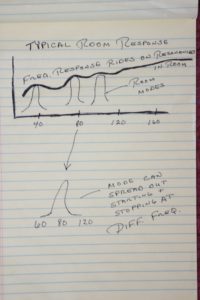Pressure Zones
The pressure zone of a room is defined as that pressure area that exists below the frequency of the lowest room mode. This pressure zone is dependent upon the room’s dimensions. The room’s dimensions will tell us what our lowest resonant frequency is going to be. Anything below that frequency we are entering the pressure zone.
Pressure Zone Pressure
The move into the pressure zone is a gradual slope within the frequency response of the room. The rate of this transition depends on the strength of the resonance. Inside our room’s pressure zones, waves of energy do not exist. They energy in the room is raised or lowered through the diaphragmatic action of the speaker driver. There are points of pressure maximum and pressure minimums within these pressure zones.
Look Below 100 Cycles
If the room is considered acoustically a small room, then we need to look at 100 cycles as the frequency where our pressure zones can be considered acoustically useful. The longest dimension in our control rooms should be at a half wavelength of the designed for lowest frequency we need to hear clearly without room resonance distortion. If we use 20 cycles as our designed for lowest frequency, then half a wavelength would be 28′. With this dimension, we would have no speaker response within the pressure zone.
Room Modal Response
Modal room responses are the track that the room’s frequency response “rides” upon. Under every trough in our frequency response curve lies a room mode. Each room mode has an amplitude and width, starting at one frequency and ending at another. This is the domain of the mode with the modal response frequency at the center point in the mode.
Q Value
Modes can have a high Q value which would be a squashed bell shaped curve and a low Q value which will result in a more peaked and narrow bell shaped curve. It is desirable to have each of these modes underlying the room’s frequency response to be at least 10 Hz. apart in order to not increase our pressure issues in different room locations.
Locate Room Modes
Looking at the frequency response of the room we now need to place that energy picture with all the underlining modes within the physical room. Lets go room mode hunting. Lets first start in the room’s corners. Next, all floor and wall boundary intersections. Third, the walls and ceiling join points and the floor to ceiling area. The strongest axial mode will between the two farthest apart room surfaces.
High And Low Pressure Areas
Between each room modal pressure area, there are areas of high and low pressure. Depending on the frequency of resonance, there will be areas of high pressure at the mode frequency and then radiating out from that high pressure area in a series of lower pressure rings as we get away from the modal frequency. This radiating effect is similar to throwing a stone in calm water. Higher pressure waves begin at the stone/water entry point and radiate out from this center point losing intensity as it moves away from the source.
Anti-Node
A loudspeaker placed into a pressure anti-mode would fill that anti-mode with pressure as sound waves generated from the loudspeaker. If we place a listener in this anti-node position, they would also hear an amplified sound. This frequency of resonance would produce no sound for a listener in an anti-node. Having all these modes in certain room positions, makes finding the correct location for both listener and loudspeaker spatially dependent.
Reflections
Reflections from room boundary surfaces can also factor to our response graph effect frequency response. If we look at the floor bounce, we see a dip in the frequency response curve of a typical room. This usually occurs around 200 cycles. The ceiling adds another bounce at 200 – 300 Hz. Increasing the same frequencies that the ceiling bounce caused. The back wall increases the hatching of our frequency response curve. Adding in the side walls, we have an all boundary response curve with many more jagged edges especially above 100 cycles.
No Cube Shaped Room
It goes without saying that we do not want two identical dimensions within our room. If we take a cube room, we have all axial modes at full strength. They will superimpose themselves upon each other and this will produce strong resonances. There will be greater spaces between modal frequencies because there will be less frequency distribution than would be the case if the height,width, and depth would be different dimensions.
Non – Parallel Walls
Non parallel wall surfaces will reduce reflections and smooth out our room frequency response. This approach will not make the number of room resonances smaller. Only room dimensions can have that impact. One can reduce some impact of resonance modes to a certain degree with non parallel surfaces. However, no standard formula exists to determine what impact and where non parallel walls will have that impact. Only the experience of the room designer can help here.







We use broadband absorption in the two most critical frequency regions in small rooms. Our Diaphragmatic absorbers, ACDA series, have…
Interesting web site and provocative introduction. Please check your copy for typos, otherwise nicely presented. I would like to see…
There is no such thing as soundproof anything especially carpet. Low frequency noise transmission requires a permanent construction fix with…
Hello Dennis! Our neighbors put a Ice Bath in their garage which is right below our bedroom and the Low…